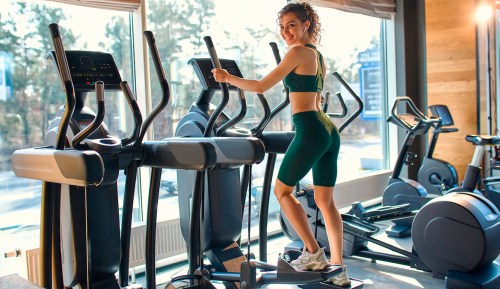5 Deadlift Variations That One Trainer Called the ‘Ultimate Total Body Exercises’
Deadlifting works all your muscle groups at once. The ultimate multitaskers. Try out these 5 deadlift variations to mix up your routine.

When it comes to strength training, deadlifting is often the first thing that comes to mind. You get stronger by carrying heavy things, right? When done with the proper form, deadlifts can work your lower back, lats, core, glutes, quads, hamstrings, and even help improve your posture and grip strength. As an added bonus, when you’ve perfected your form and are doing higher repetitions of the exercise, your strength training can even serve double duty and help improve your cardiovascular health by boosting your heart rate.
Experts in This Article
certified personal trainer and Tonal strength coach
a certified personal trainer, nutrition coach, and mindset mentor
fitness trainer and founder of Thrive Health Lab
Liz Zarins is a personal trainer based in Los Angeles.
certified personal trainer and CrossFit coach at Koda CrossFit
Given that the move is a surefire way to build muscle—in fact, Brianna Bernard, CPT, Isopure Athlete calls them “the ultimate total body exercise”—it seems like a no-brainer that you’d want to add them to your routine. However, for many people, deadlifts can feel intimidating, and for others monotonous. Luckily there are a whole host of deadlift variations that you can try out to see what works for you. Scroll down to learn everything you need to know about the benefits of deadlifting, five deadlift variations to try, and how to do each, according to top trainers.
What are the benefits of deadlifts?
1. They work almost every muscle group
Deadlifts are the ultimate multitaskers. Just by keeping your spine neutral, knees bent, and hinging from the hips, then standing and repeating the movement with a barbell, you’re working nearly every single muscle group with just one fluid motion. “With proper form, your forearms engage from holding the bar; your shoulders, traps, back, and core help stabilize the body; and your glutes and hamstrings act as a lever to lift the weight,” LaNiecia Vicknair, corrective exercise specialist and founder of Thrive Health Lab, previously told Well+Good readers.
2. They can help improve posture
Deadlifts are a type of functional fitness. This means that the required movements mimic many of the classic activities that we do in our day-to-day lives (read: picking things up and putting them down, bending, and coming up to stand). By adding deadlifts to your workout routine, you are strengthening the muscles required to do these motions, making them easier and safer to do, while also helping improve your form when you do them. Because of the variety of muscle groups worked in a deadlift—two being the core and back muscles—deadlifting can help counteract the effects of work-from-home sedentary behavior.
3. They are easy to adapt and modify
Deadlifts are a very “come as you are” exercise. You can do them with any level of weight or even adapt them to not use weights if you are injured or don’t want to risk straining your muscles. They are also a great exercise that allows you to track your progress because, since the lift will get easier over time as you perfect your form and get used to the resistance, you can add more weight on bit by bit.
Ready to try out some deadlift variations for yourself? Follow along with step-by-step instructions from three top trainers.
What are the different deadlift variations?
Traditional deadlift
1. Stand behind your barbell with your feet hip-width apart.2. Bend over with a neutral spine and grab the barbell with your hands shoulder-width apart.3. Bend your knees and position your toes slightly outwards so the barbell just barely grazes your shins.4. Engage your glutes and core.5. Lift the bar while pressing the soles of your feet into the ground.6. Bring the barbell up and push your hips forward to bring you to standing.7. Reverse the movement and bring the barbell back to the ground.8. Repeat.
Romanian deadlift
1. Begin with your feet under your hips in a strong, comfortable stance.2. Hold the barbell in front of your legs at thigh height.3. Begin hinging, by folding at the hips and bending with a neutral spine.4. Imagine sliding the barbell along the front of your legs, stopping at mid-shin height.5. Lock your shoulders back and drive through your heels while thrusting your hips forward to return to a strong standing position.6. Repeat.
B-Stance deadlift
1. Stagger your stance so that your feet are hips-width apart, but with one leg behind the other, keeping the big toe of your back leg in line with the heel of your front leg.2. Hold the barbell in front of your legs at thigh height.3. Begin hinge by folding at the hips and bending with a neutral spine.4. Imagine sliding the barbell along the front of your legs, stopping at mid-shin height.5. Lock your shoulders back and drive through your front foot, using your back foot for support and balance, while thrusting your hips forward to return to a strong standing position.6. Repeat.
Single-leg deadlift
Use bodyweight or a light dumbbell rather than a barbell for this variation.
1. Stand with your feet hip-width apart.2. Shift your weight to one leg, while making sure to have a slight bend in the knee.3. Push your other foot back behind you with a straight leg and flexed foot.4. Hinge at the waist with a neutral back until you are nearly parallel with the ground while keeping your arms straight in front of you, at shoulder height.5. Bring your elevated leg forward and lift to standing.6. Repeat.
Sumo deadlift
1. Stand behind your barbell with your feet wider than hip-width apart and your toes pointed outwards at about a 45-degree angle.2. Bend over with a neutral spine and grab the barbell with your hands shoulder-width apart.3. Bend your knees so the barbell just barely grazes your shins.4. Engage your glutes and core.5. Lift the bar while pressing the soles of your feet into the ground.6. Bring the barbell up and push your hips forward to bring you to standing.7. Reverse the movement and bring the barbell back to the ground.8. Repeat.
What form mistakes should you look out for?
1. Diving forward
According to trainer, Ash Wilking, one of the most common mistakes that she sees is that people dive forward. This means that they have a rounded back rather than a neutral, flat spine. It’s important to sit your hips back, keep your arms tight to the legs, and find a deep hinge pattern when you’re deadlifting.
2. Not creating a circuit of tension
“Creating a circuit of tension before beginning to lift the weight is essential for good form and injury prevention,” explains trainer Nolan Parker. This is commonly referred to as “pulling the slack out of the bar.” Before you begin your lift, you must be fully braced against the ground and the bar. “Any body part that is not engaged is at risk of injury. Most deadlifts go awry when folks try to yank the bar aggressively off the ground before they have braced fully,” he adds.
3. Wrong setup
Parker also finds that most faults when it comes to deadlifting start in the setup. “Finding the right hip height as a starting point and recognizing limitations in mobility will eliminate many deadlift mishaps. If you are new to lifting or know that your mobility is lacking, then you may find it beneficial to practice deadlifting off blocks or a rack that brings the bar to a higher starting position. This will make it easier for you to engage your posterior chain,” he explains.
4. Incorrect hand placement
Trainer Liz Zarins reminds us of the importance of proper hand placement in deadlifting. Incorrect hand placement can cause strain and injury because it causes misalignment, “cranking the neck so it’s not in line with the spine, and a rounded back,” she explains.
What are some exercises you can do to prepare for deadlifting?
According to Wilking, there are a few deadlift alternative exercises you can do to prepare yourself for any of the deadlift variations above. Try doing bodyweight ‘Good Mornings’ to start. Since the movement requires you to place your hands behind your head, this will reenforce leading with the chest proud rather than diving and rounding your shoulders. Bodyweight movements are also always the best way to practice the movement pattern before introducing weight. Doing weighted or bodyweight bridges or shoulder elevated hip thrusts will also help you get in the habit of controlled movement in your posterior chain.
Click on the video below to learn how to do a single leg deadlift the right way.
Oh hi! You look like someone who loves free workouts, discounts for cutting-edge wellness brands, and exclusive Well+Good content. Sign up for Well+, our online community of wellness insiders, and unlock your rewards instantly.










